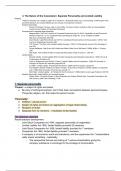3. The Nature of the Corporation: Separate Personality and Limited Liability
Reading:
- **Pettet’s Company Law, chapter 2 pages 34-37 (section 2.1 (Corporate entity) up to, but excluding, ‘B Piercing the Veil’)
and 48-56 (Sections 2.2 (Limited liability) and 2.3 (Groups of Companies) inclusive)
- Separate personality
- Edward, First Baron Thurlow, cited in John Coffee, ‘No Soul to Damn: No Body to Kick’ An Unscandalized
Inquiry into the Problem of Corporate Punishment
- Consequences of separate legal personality
- Margaret Blair, The Four Functions of Corporate Personhood (April 9, 2012). Vanderbilt Law and Economics
Research Paper No. 12-15; Vanderbilt Public Law Research Paper No. 12-15. Available at SSRN:
http://ssrn.com/abstract=2037356
- David Gindis, ‘Legal Personhood and the Firm: Avoiding Anthropomorphism and Equivocation,’ (2016) 12(3)
Journal of Institutional Economics 499.
- P.W. Ireland, ‘The Rise of the Limited Liability Company,’ (1984) 12 International Journal of the Sociology of
Law 239.
- Doreen McBarnet, ‘After Enron Will ‘Whiter than White Collar Crime’ Still Wash?’ (2006) 46 Brit. J. Criminol
1091
- Max Radin, 'The Endless Problem of Corporate Personality' (1932) 32 Colum. L. Rev 643
- Limited liability
- Bernard Cataldo, 'Limited Liability With One Man Companies and Subsidiary Corporations,' (1953) 18 Law &
Contemporary Problems 475.
- Frank H. Easterbrook and Daniel R. Fischel, 'Limited Liability and the Corporation,' (1985) 52 University of
Chicago Law Review 89, especially pages 89-109
- S. Griffin, ‘Limited Liability: A Necessary Revolution?’ (2004) 25 The Company Lawyer 99.
- Paul Halpern, Michael Trebilock and Stuart Turnbull, 'An Economic Analysis of Limited Liability in Corporation
Law,' (1980) 30(2) University of Toronto Law Journal 117
- Ben Pettet, ‘Limited Liability – A Principle for the 21st Century?’ (1995) 48(2) Current Legal Problems 125-159.
- Separate personality, limited liability, and corporate groups
- Robert Austin, ‘Corporate Groups’ in Ross Grantham and Charles Rickett (eds), Corporate Personality in the
20th Century (1998, Hart Publishing) 71-89.
1. Separate personality
‘Person:’ a subject of rights and duties
● Be wary of anthropomorphism: don’t think draw connections between person/company.
Things like religion, etc. that make the person human.
“Personality”
● Artificial v natural person
● Subject of rights and duties (an aggregation of legal relationships)
● Recipient of duties
● Separate from its members – it facilitates limited liability
The Salomon doctrine
Recall statutory development:
- Joint Stock Companies Act 1844, separate personality on registration
- Limited Liability Act 1855, limited liability provided 25 members
- Joint Stock Companies Act 1856, limited liability provided for 7 members
- Companies Act 1862, limited liability provided 7 members
- A company is of economic worth and substance, and the requirement for 7 shareholders
really meant something - materiality.
- The perspective that we are looking at 7 serious shareholders giving the
company substance in exchange for the privilege of incorporation.
, Salomon v Salomon & Co Ltd [1897] AC 22
● The principle: it is possible to regard a shareholder who is employed as a pilot by
the company as a “worker” (within the meaning of statute) even though he
controlled the company and was its chief executive.
○ Company has separate legal personality regardless of motivations for
incorporating
● Facts: S was a sole trader, personally owned the assets of a business - he was the face
of the business. Decided to incorporate a business (set a company rather than act as a
sole trader).
○ Initial company structure: Aron Saloman and Company Ltd
■ S (previously sole trader) 1 share, S’s wife, daughter, 4 sons 1 share
each,
○ Then S allotted an extra 20k shares to himself. Not only the director, but also
the shareholder. Had control at the board level and the shareholder level.
■ AS 20,001 shares, family members 6 shares. They were mere nominees -
to make up the numbers.
● How did AS incorporate the business in the first place?
○ Contract for the same of business assets (38k) went in
○ Debentures (10k) issued by the company in part payment of consideration. The
debentures became the subject of dispute
■ To the outside world, he was still very much the business. Was it
right that the incorporation could shield him from liabilities?
○
○ Now the company owes Edmund Broderip
○





